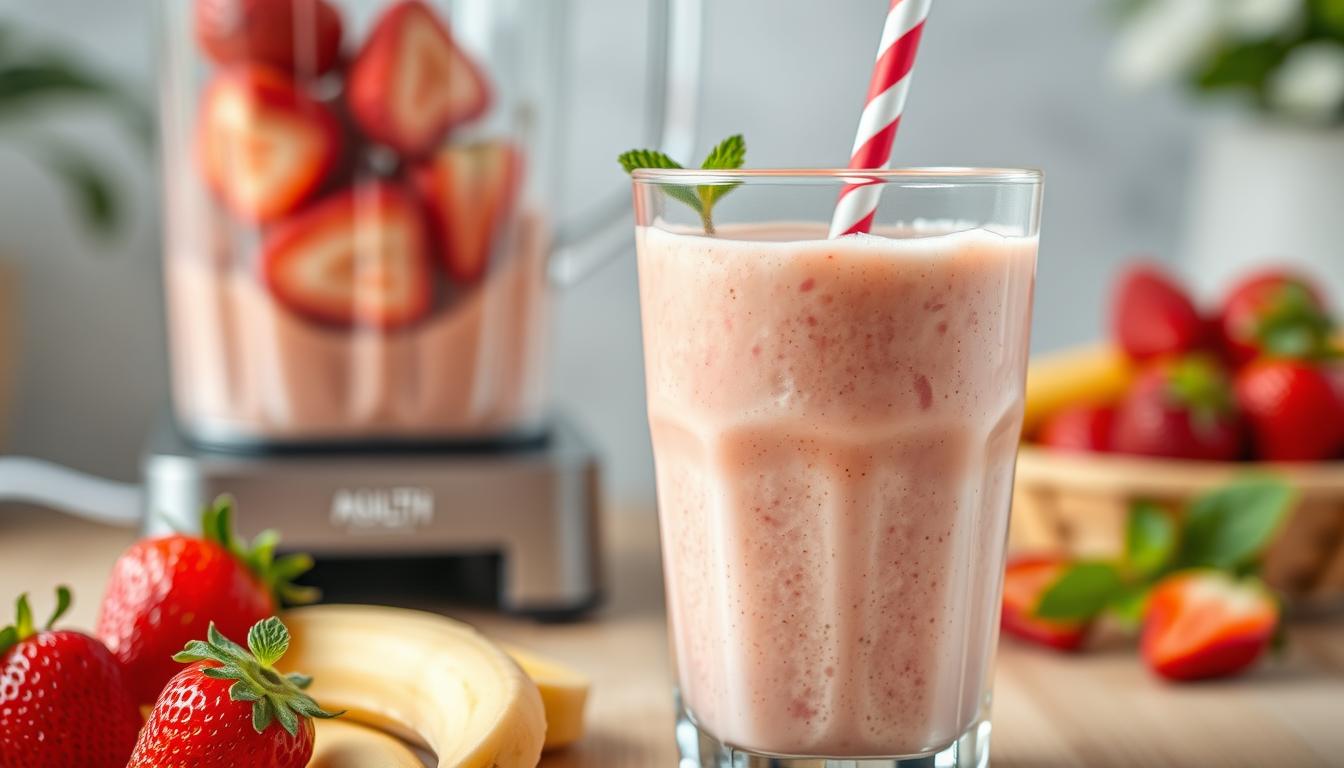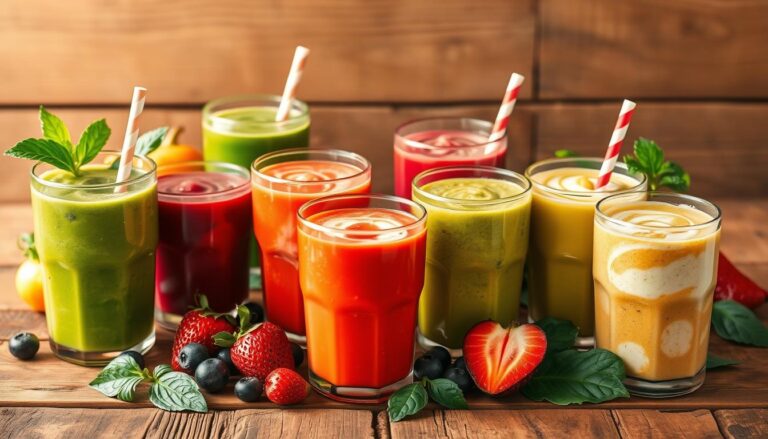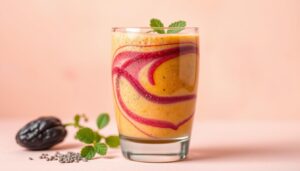How Many Calories in a Strawberry Banana Smoothie is the question you ask when you want a vegan-friendly, satisfying breakfast that fits your goals.
Want a quick, data-backed answer? A homemade vegan-style blend with strawberries, banana, unsweetened almond milk, almond butter, optional maple syrup, and ice runs about 240 calories per serving. That estimate gives roughly 6 g protein, 5 g fiber, and 10 g fat based on USDA calculations.
Using frozen fruit and overripe bananas boosts sweetness and texture. A high-powered blender makes this ready in about five minutes and keeps the drink cold and ultra-smooth.
You’ll find which ingredients drive total calories and how to swap dairy-free milk or yogurt to keep it plant-based. Use the smoothie generator to personalize your macros and servings: https://healthconservatory.com/smoothie-generator.
Key Takeaways
- The guide answers “How Many Calories in a Strawberry Banana Smoothie” with clear numbers.
- A typical vegan recipe ≈ 240 calories, 6 g protein, 5 g fiber, 10 g fat.
- Frozen fruit and ripe bananas improve sweetness without added sugar.
- Almond milk and almond butter keep the drink plant-based and creamy.
- Blend in a high-powered blender for five minutes for best texture.
- Use the smoothie generator to tailor calories and macros fast.
How Many Calories in a Strawberry Banana Smoothie: The Vegan-Friendly Answer
Want clear numbers you can use today? Start by thinking about portions and ingredients. Small tweaks to plant milk, yogurt, or add-ins change totals quickly. You’ll see why store options often run higher on sugar and lower on protein.
Calories per serving today: what changes your total
Your total calories per serving depend on fruit quantity, type of plant milk, sweeteners, and nut butters or seeds for texture and nutrition.
Typical homemade ranges sit around 200–300 calories for an 8–10 oz serving. A careful homemade, using measured fruit and dairy-free yogurt, can be closer to 146 calories per serving with higher protein and less than 20 g sugar.
Quick comparison: homemade vegan vs. store-bought
Store-bought or fast-food smoothies can be convenient but often bring more sugar and less protein. For example, a small fast-food option is about 190 calories with 39 g sugar and only 2 g protein.
- Make strawberry banana at home to lower sugar and boost protein.
- Choose almond, soy, or pea-based milk to match your macro goals.
- For a filling snack or post-workout drink, add plant protein—this raises calories slightly but improves satiety.
- Plug ingredients into our smoothie generator to see instant totals and serving guidance.
Key Ingredients for a Vegan Strawberry Banana Smoothie
Choose your base ingredients with texture and sweetness in mind. The right mix keeps your drink creamy while staying plant-based and low on added sugar.
Fresh or frozen: fruit choice
Frozen strawberries give a thicker, colder drink; fresh blends faster and may need ice.
Use one medium banana or an overripe one to boost natural sweetness and cut added sweetener.
Plant milk and dairy-free yogurt
Unsweetened almond milk or coconut milk keeps sugar down and adds creaminess.
Dairy-free yogurt made from almond or coconut adds body and tang without dairy. A plain Greek-style vegan yogurt gives extra thickness.
Sweeteners and mix-ins
Start with fruit sweetness and add a vegan sweetener only when needed. Maple syrup or dates are simple swaps for honey.
For richness, add 2 tbsp almond butter or a scoop of plant protein. A pinch of salt balances flavor without adding calories.
| Ingredient | Typical amount | Texture impact | Sugar impact |
|---|---|---|---|
| Strawberries (frozen) | 1 cup | Thicker, colder | Low–moderate |
| Banana (ripe) | 1 medium | Sweeter, smoother | Moderate |
| Unsweetened almond milk | ½–1 cup | Light, creamy | Low |
| Almond or coconut yogurt | ¼–½ cup | Thickens, adds tang | Depends on sweetened vs plain |
Tip: Use the smoothie generator to tweak your ingredients and see exact totals: https://healthconservatory.com/smoothie-generator
Step-by-Step: Make a Healthy Strawberry Banana Smoothie
Load ingredients in layers so the blades form a steady vortex and finish quickly. Follow this simple order to get a silky, lump-free result with a short blend time.
Prep and load order for ultra-smooth blending
Hull strawberries, peel your bananas, and measure liquids into a cup for consistent calories. This makes the recipe repeatable each time.
Place softer items like peeled bananas and dairy-free yogurt closest to the blades. Add nut butter or protein next, then pour plant milk.
Top with frozen strawberries so the blades can catch and pull everything down. This is the easiest way to avoid chunks.
Blend time, consistency checks, and quick fixes
Start the blender on low, then ramp up for about 1–2 minutes until smooth. Most vegan combos finish in roughly 5 minutes total from prep to pour.
- If the motor stalls, stop, add a splash of milk, and pulse to re-engage the vortex.
- For thicker texture, use more frozen strawberries or less liquid; for thinner, add milk 1–2 tablespoons at a time.
- Use overripe bananas to boost sweetness and improve mouthfeel without extra sweetener.
- A high powered blender helps, but proper load order works with any reliable machine.
Tip: Pre-portion fruit into measured cups so you can assemble and blend in minutes. When you want to make strawberry banana your go-to, this saves time and keeps totals accurate.
Want exact macros for your mix? Use the smoothie generator to personalize servings and see instant totals.
Calorie Breakdown and Nutrition per Serving
Understanding ingredient effects helps you tailor each serving to your goals. Below is a clear look at typical ranges and the trade-offs between texture, protein, and added sweeteners.
Typical ranges per serving and why they vary
Expect roughly 200–300 calories for an 8–10 oz serving when you control portions and add-ins. A vegan-friendly recipe with almond milk and almond butter lands near 240 calories per serving.
Protein, fiber, and sugar: balancing your macros
That 240-calorie healthy strawberry banana example gives about 6 g protein and 5 g fiber. A leaner cup-based approach can drop to ~146 calories while hitting ~7.5 g protein if you use a higher-protein plant base.
- Higher calories come from nut butter, sweeteners, and richer milk.
- Use plant yogurt or protein powder to boost protein without dairy.
- Limit added maple or honey to 1–2 teaspoons to control sugar.
| Scenario | Approx. calories | Protein | Notes |
|---|---|---|---|
| Standard vegan mix | ~240 | 6 g | Almond milk, almond butter, strawberries |
| Leaner measured cup | ~146 | 7.5 g | Higher-protein milk or yogurt alternative |
| Higher-calorie add-ins | 300+ | 8–12 g | Extra nut butter, seeds, or sweetener |
Tip: Measure fruit and milk by cup or weight so each serving matches your plan. When you want to make strawberry banana drinks work with goals, precise portions help most.
Pro Tips: Use Overripe Bananas, Frozen Strawberries, and a High-Powered Blender
Try overripe fruit and frozen berries to speed blending and boost natural sweetness. Use overripe bananas to sweeten your drink and cut added sugar. Frozen strawberries add body and a frosty texture that replaces ice.
Choose a high powered blender—brands like Vitamix, Blendtec, or Nutribullet finish blends in about 1–2 minutes. This is the easiest way to get a silky finish without reheating flavors.
- Freeze fruit flat on parchment, then move to a bag so pieces stay separate.
- If the blender stalls, add a splash of milk and pulse, then scrape down the sides.
- Add almond butter after the first quick blend for creamier texture and easier mixing.
- Store pre-portioned packs in the freezer for grab-and-blend convenience on busy mornings.
| Tip | Benefit | Time |
|---|---|---|
| Overripe banana | More sweetness, smoother blend | None |
| Frozen strawberries | Thicker, colder texture | None |
| High powered blender | Silky finish fast | 1–2 minutes |
These small moves make your smoothie more reliable and faster. Follow them and you’ll save time while keeping flavor bright and plant-based.
Make-Ahead, Fridge Storage, and Freezer Methods

Set up grab-and-blend packs so you can build a fresh drink in just minutes each morning. Measure frozen strawberries, banana chunks, and dairy-free yogurt into a freezer bag. Seal and label each bag with the date and portion size.
Meal-prep packs for busy mornings
Assemble freezer-ready packs by measuring fruit and dairy-free yogurt into one bag. Add seeds or oats so nutrients mix evenly.
When ready, let the bag sit 15–30 minutes to loosen, then pour plant milk into the blender first so the blades catch the frozen mix. Blend until smooth for a fast vegan breakfast.
Freezer-to-blender strategies that keep texture
If you batch-blend for same-day drinking, refrigerate the drink and sip within hours for best taste.
For longer storage, freeze your blended portion in a bottle with headspace and thaw overnight in the fridge. Shake or blend briefly after thawing to restore texture.
- Label each cup-based portion so you know how many servings you’re thawing.
- Avoid repeated thaw-refreeze cycles; blend again briefly if separation occurs.
- Rotate fruit combos to keep flavors interesting while keeping predictable macros.
- Use prep packs to reduce waste from overripe bananas and speed morning routines.
Want exact macros for each prep pack? Use the smoothie generator to personalize ingredients and get instant totals before you freeze.
Vegan Variations to Boost Nutrition and Flavor
Upgrade your base with plant-powered boosters for longer satiety and richer texture. These simple swaps keep your drink vegan while adding more protein and fiber.
Protein and fiber boosters
Protein: Add a scoop of plant protein powder to turn your banana smoothie into a filling meal. Use pea or soy to keep it creamy and lean.
Fiber: Stir in oats, chia, or ground flax. Start with about one tablespoon and adjust for thickness and taste.
Greens and fruit twists
Add a handful of spinach for a mild greens boost that won’t overpower the fruit. Swap in mango or blueberries for a fresh flavor shift and extra antioxidants.
Nut and seed butters for staying power
Two tablespoons of almond or sunflower seed butter add richness and lasting energy. For a dessert-leaning treat, mix in cocoa or cinnamon and a splash of vanilla.
“Small add-ins can make the same recipe work as breakfast, snack, or post-workout fuel.”
Tip: If you need lower sugar, reduce banana and add more frozen strawberries or unsweetened plant yogurt. Blend add-ins after the base is smooth, then pulse until just combined.
Try Our Smoothie Generator to Personalize Calories and Macros
Build the perfect plant-based blend in seconds. You can test portions, swap milks, and see nutrition update immediately. This is the fastest way to match a smoothie recipe to your goals.
Create your vegan smoothie, see calories instantly
Input typical components—measured cups of strawberries and banana, plant milk type and amount, dairy-free yogurt, nut butter, and add-ins—to view calories, protein, sugar, and fiber per serving.
Start now: https://healthconservatory.com/smoothie-generator
- Build any smoothie recipe by selecting fruit amounts in cup measures, choosing milk or milk almond milk, and adding yogurt or nut butter.
- See precise calorie and macro impacts so your healthy strawberry banana goals match your plan.
- Compare almond vs. soy vs. oat milk and watch how protein and calories shift per cup.
- Toggle banana amounts to manage sugar and texture while keeping strawberry banana flavor.
- Export per-serving results so you never guess portions again for your banana smoothie routine.
“Personalize each blend and make strawberry banana smoothies that fit your day.”
Call to action: Start now and personalize your vegan smoothie calories and macros: https://healthconservatory.com/smoothie-generator
Conclusion
Now you can tweak fruit, milk, and add-ins to match your nutrition targets without guesswork. For most home builds expect roughly 200–300 calories per 8–10 oz serving; a typical vegan-friendly example hits about 240 calories with ~6 g protein and ~5 g fiber.
Keep your strawberry banana smoothie plant-based by choosing unsweetened almond milk and a dairy-free yogurt. Use frozen strawberries and an overripe banana for texture, and measure ingredients so each recipe stays consistent.
Prep freezer packs in a bag and use a reliable blender to save minutes on busy mornings. Balance protein and fiber with seeds or plant protein to cut sugar and boost satiety.
Ready to personalize? Use the smoothie generator to build your banana smoothie, adjust milk and add-ins, and see per-serving results instantly: https://healthconservatory.com/smoothie-generator. This is a strong, actionable call to action to plan your healthy strawberry banana batches.




